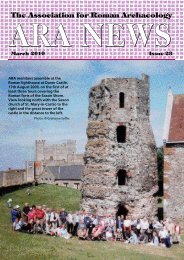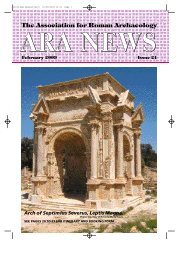Newsletter Issue 22 - Association for Roman Archaeology
Newsletter Issue 22 - Association for Roman Archaeology
Newsletter Issue 22 - Association for Roman Archaeology
You also want an ePaper? Increase the reach of your titles
YUMPU automatically turns print PDFs into web optimized ePapers that Google loves.
G0071,ARA <strong>Newsletter</strong><strong>22</strong> 01/11/2009 18:43 Page 8Fig. 2. The fate of Caerwent. Photo: © Roger White.can be found in his book entitledBritannia Prima. Some towns mayhave bucked the trend, e.g. Chesterwhere a Bishop and a Synod arerecorded <strong>for</strong> AD 617. There weretowns in the fifth and sixth centuries– but small and unimpre s s i v e .<strong>Roman</strong>s would not have consideredthem towns. There were few publicbuildings – a few churches but mainlyoutside the walls. Industry was smallscalemetal and bone working.Houses and other buildings were oftimber.A fuller discussion in a longer version ofthis report is available. This also includesuseful re f e rences. Please contactrebecca_isis@yahoo.co.uk if you wouldlike a copy.Late <strong>Roman</strong> and early post-<strong>Roman</strong> Leicester – RichardBuckley – University LeicesterArchaeological ServicesUntil recently, evidence <strong>for</strong> activity inthese periods remained elusive, butsome has been provided by recentlarge-scale redevelopment projects.The Highcross Development siteseems to show continuousoccupation since <strong>Roman</strong> times,leading to over 3.5 metres ofarchaeological deposits. A large postbuiltstru c t u re was discovere d ,p e rhaps a hall, cutting into asubstantial area of what may havebeen the <strong>Roman</strong> macellum. Resultshave not yet been fully evaluated, sothe issue of sub-<strong>Roman</strong> activity is stillopen.Verulamiumbetween the<strong>Roman</strong>s and Saxons – RosNiblett – University CollegeLondonEvidence is accumulating <strong>for</strong>continuing, ifdiminished, fifthc e n t u ry occupationin thetown. There is thefifth centurywater-pipe foundby Frere in InsulaXXVII, and there f e rence to St.G e rmanus‘s visitto St. Albans.Early Saxon settlementis larg e l yabsent, and asmall British populationenclavemay have still been there when Offafounded a monastery on the site ofSt. Alban’s grave. It may besignificant that the Late Saxonabbots had ‘problems’ with theKingsbury area, which they claimedwas the residence of ‘strumpets’, andeventually persuaded Edgar to sell itto the Abbey. But was it ane m b a rrassing area where theoriginal, but heretical, British stilllived?Silchester – the end of anearly medieval town – MikeFul<strong>for</strong>d – University ofReadingThe town continued to be vibrantbeyond the early fifth century, butd i ff e re n t l y. The <strong>for</strong>mer Foru mBasilica was used <strong>for</strong> iron-making inthe fourth century and continuedinto the fifth century. Wells remainedin use in the fifth century as didf o u rth century pottery styles –evidence of a resident populationbut with diminished economicactivity. A dwarf column with Celtic‘Ogham script’ (developed in Irelandlate fourth century) is found dumpedin a well along with coins ofTheodosius, and cattle bones arestuffed into a second well. This mayindicate a ritual ‘closure’ of the citysometime after 500.From Durovernum toDurobernia CanterburyAD 300 - 700 – AndrewRichardson – Finds ManagerCanterbury ArchaeologicalTrustThe Tannery and Marlow Car Parksites show signs of rebuilding late inthe fourth century, and perhaps earlyin the fifth century, but it is not clearhow long after AD 410 thesebuildings continued in use. In theAugustine House excavations someoccupation along the southernf rontage of Watling Street isbelieved to have continued into theAnglo-Saxon period. There is someevidence <strong>for</strong> occupation andindustrial activity – kilns – to then o rth-east of Augustine House.Anglo-Saxon structures are foundafter AD 450, but there may be a gapin the early fifth century.There are many examples of irregularburials in the late fourth century –bodies are thrown into a pit to getrid of them, rather than buried. Is thisevidence of a plague? Was this thereason <strong>for</strong> the evacuation of the city– not the <strong>Roman</strong> departure? It wouldexplain the odd hiatus in buildinglasting perhaps only 50 years. Afterc. AD 600 a new street pattern beginsto emerge. What happened c. AD 425to c. 590 is not clear.Under the Portable AntiquitiesScheme, coin finds suggest ascenario. Coin loss across East Kent inthe fifth century is significant. Thereis a considerable density of findsoutside Canterbury, especiallyaround Faversham. In the mid-sixthcentury this becomes an importantproduction centre, perhaps becauseof its access to the Wansum Channel,which provides access to Kent fromScandinavia. But there is a markedabsence of coins found inCanterbury. Canterbury seems to beinitially peripheral to the earliestpost-<strong>Roman</strong> activity in England. Butits strategic location and the politicalambition of Ethelbert power a‘comeback’. Perhaps Augustine’smission was pre - a rranged as adiplomatic coup, to supportEthelbert’s ambitions to rule all ofKent.<strong>Roman</strong> York – Fourth Centuryand Beyond – Mark Whyman –York Archaeological TrustMark re p o rted on his re c e n tunpublished PhD study of evidencefrom the Wellington Row excavationin the colonia. Coins with a terminuspost quem of AD 367, and evidenceof rebuilding in this period mayindicate continued occupation wellinto the fifth century. Coins ofTheodosius have been found, alsoevidence of alterations to existing8




